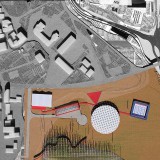Supervisor:
2024
This work describes the process towards formulating a proposal for the connection, re-programming, completion and activation of two unfinished public buildings located at the Eastern Entrance of Aridaia: the covered market and the swimming pool complex.
Aridaia is a small town in the regional unit of Pella and serves as the administrative center and geographical hub of the Municipality of Almopia. The Municipality extents over a very large area and has a distinctive profile due to its geomorphology; It consists of a plain surrounded by mountains forming an almost closed basin. However, the lack and the abandonment of infra-structures that could potentially offer choices related to leisure activities make the feeling of isolation and nullification in the region even more intense.
Experiential insights, on-site research, context analysis, archival investigations, discussions with locals, and information gleaned from tracking local and national mediaaffairs converge in certain instances with references from architectural history. Additionally, an assessment of the area’s strengths and weaknesses is conducted, aiming to enhance the former and address the latter. These elements inform architectural experiments involving models and sketches related to both buildings and the broader area.
Through evaluating the research results and trial efforts, a strategic plan ultimately emerges for activating these structures and connecting them to new or existing networks of the city and its periphery. Particular emphasis is given to the relocation of the bus station which acts as an important factor for the activation of the area.
This strategy aims to transform the area into a hub that welcomes people from all of Almopia, especially the students of the neighboring to the studied buildings schools, granting them access to cultural and sports-related experiences that are currently lacking in the region. Simultaneously, this activity will extend to the municipality’s periphery through the projected networks, activating additional public spaces and thus contributing to the resilience and openness of the region.
